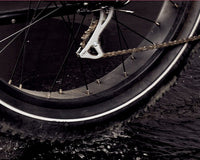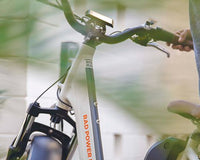An ebike doesn’t just get you out into the world. It also helps protect it. To celebrate Earth Month, we're putting the spotlight on all of the places the Rad Community loves.
Have a favorite riding spot? We want to hear all about it! For a chance to be featured on our channels, shoot a photo or video (30 seconds or less) telling us where it is, how your ebike helps you get there, and why you love it. Tag us on social at @radpowerbikes and use the hashtag #RadPlacesWeLove to participate, or upload your photos and video directly on our site.
Earlier this month, we asked our riders to share some photos and videos of the places they love -- and they didn’t disappoint!
We got to see all kinds of great riding spots, from majestic deserts to lush forests, from sprawling trails to tucked-away urban oases.
Since it’s Earth Month, we’ve spent a lot of time focusing on the environment. That got us thinking about how climate change could impact some of our favorite outdoor spaces. After all, it’s been less than a year since wildfires kept those of us in Seattle inside and off the trail for nearly two weeks. What role did climate change play? Will it get worse? And what else should we expect in the years to come?
To get some answers, we turned to Dr. Kristina Dahl, a senior climate scientist with the Union of Concerned Scientists, a nonprofit organization working to educate the public about the threats facing the planet. It turns out she’s been known to ride an ebike herself, so it's safe to say she understands the joy that comes with spending some time outdoors.
Here are a few ways she warned that climate change can impact the places we love -- and why it matters to the Rad Community.
More Extreme Heat Days

Have you ever felt like it was just too hot to ride? While that can be a challenge for some riders during the summer months, climate change can make those scorching days both hotter and more frequent.
“As the globe warms in response to rising carbon dioxide emissions and other heat-trapping gases, we can expect temperatures to warm even more than they have to date,” Dahl told us. “Some of our work has shown that the frequency of extreme heat days will increase substantially between now and the middle of the century, say 20, 30 years.”
This won’t just make it uncomfortable, and in some cases, flat-out unhealthy, to perform physical activity outside, but it could also pose a danger to some of the little things we enjoy in nature as well.
“The ecosystems in the places we enjoy will respond to warming temperatures in ways that are going to be unique to each area,” Dahl said. “For example, the wildlife that you typically like to see in natural places may no longer be able to survive there. We might also see certain species of trees no longer growing successfully in places where they’ve typically thrived.”
Heavier Rain, More Floods
While warmer temperatures may make you think of dry, arid land, all of the water that gets evaporated has to go somewhere. According to the science, that means a greater risk of frequent, more intense storms.
“One thing we have to be aware of is changing precipitation patterns. Across much of the U.S., we can expect to see more rain falling in very extreme, very heavy downpours,” Dahl warned.
Heavy rain can ruin your ride, but the impact goes a lot deeper than a spoiled weekend. Once the storms clear, Dahl said, the places we love could also look a lot different.
“These downpours can create more landslide and flooding risks. Some of the spaces people might typically go to enjoy, like landscapes in the mountains or on riversides, could be virtually unrecognizable."
Smoke and Fire
Climate change can lead to increased drought and drier trees. In short, the perfect recipe for wildfires.
“A lot of your West Coast riders will likely have direct experience with what it's like to live through a severe wildfire season,” Dahl noted. “They know that being outside to hike or bike, or even just to walk when when the air is thick with wildfire smoke can be not only unpleasant, but dangerous to our health.”
“Then there’s also the immediate risk to the places themselves that might be burning, which are often beautiful forests. Fire will absolutely shape the places that we like to explore.”
While forest fires have always been a natural occurrence, certain trends, like outdated fire suppression techniques and more housing developments popping up in rural areas, have raised new, dire concerns.
“When a fire does spark in those places, they're going to burn more easily and they're going to burn hotter,” Dahl explained. "We’re now seeing more of what fire scientists call canopy fires, which is when fires are burning entire trees, up into their canopies. When we get fires like that, they're difficult to control and can spread much more quickly, sometimes over highways or in ways firefighters just haven’t seen before.”
Protecting the Places We Love

So how do we prevent the places we love from becoming the places we've lost?
Climate change is a global issue. Therefore, as Dahl tells it, any solution has to be rooted in big, systemic change at the international level.
But that doesn’t mean individual choices can’t play a role -- especially if you inspire others to follow your example.
“A decision to buy an electric vehicle or an electric bike is not just a personal choice, it’s something that your neighbors will see. It's a signal to the car companies that this is what we want to see,” Dahl said. “Those changes can help to catalyze a society-wide shift in thinking about the resources that we're using and the energy sources that we are drawing from.”
"All those little choices can add up," she added. "Especially if lots of people are making them."
Turning to an electric bike is, of course, just one step. If you're looking for other ways you can make a difference, check out the Earth Day Network's guide to confronting climate change or connect with like-minded volunteers in your community.
Ready to embrace the next generation of mobility? Zero in on the best electric bike for you with our online ebike picker. Already riding Rad? Check out our emissions calculator to see how you're cutting down on your carbon footprint.








